| Deep Sky Objects: Star Clusters |
| HOME Best Lunar Planets Deepsky Misc Equipment Techniques Links | Galaxies Nebulae Star Clusters Constellations Multiple Stars Messier objects |
There are two types of star cluster shown here:
Open clusters are large objects containing anything from a few tens to several thousand of (normally young, hot) stars in an open group, as the name would suggest. Often they are visible to the naked eye, the most famous being the Pleiades or Seven Sisters (M45). Because of their size, open clusters are best viewed using very low magnification, often looking their best in binoculars.
Globular Clusters are much smaller but contain many more stars (up to a million) than open clusters. The stars are normally very old. They are compact objects with the stars tightly packed, although some stars in the cluster form a halo around the core of the object, giving globular clusters the appearance of a fuzzy star under low magnification. Viewed at high magnification though, the individial stars can be resolved.
Click on the pictures to expand and see captions |
6 December 2008: The Owl (or E.T.) Cluster
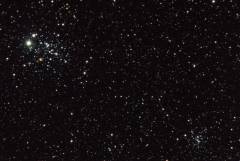
|
NGC457 is known as the Owl Cluster, or as the E.T. Cluster. These names both refer to those two bright stars, that appear a little like eyes. When I composed this shot I noticed that NGC436 was also in the field of view - you can see it at the lower right of this image.
Details:
| |||||
| to top | home | |||||
11 October 2008: M103 Open Cluster
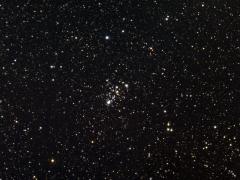
|
Messier 103 is a small but attractive open cluster in Cassiopeia. I took some relatively long exposure times and achieved a nice result.
Details:
| |||||
| to top | home | |||||
12 April 2008: M53 Globular Cluster
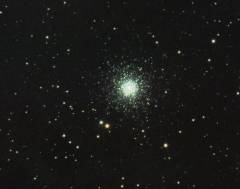
|
M53 is a rather distant globular cluster. I found it with my Megrez on Saturday
night 12 April, and here is the LRGB image that resulted.
Details:
| |||||
| to top | home | |||||
14 November 2007: M45
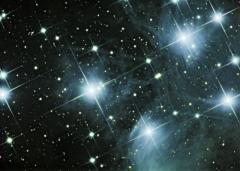
|
This is an LRGB image of M45 the Seven Sisters or Pleiades, one of the most attractive open clusters in the sky, and one that is bright enough to be visible with the naked eye. For this picture I had some cotton thread across my telescope's aperture, which caused the prominent diffraction spikes to appear on the bright stars in the picture. Since the cluster contains so many bright stars, there are a lot of spikes! The Pleiades is a young cluster, and is passing by a cloud of gas which is being lit by reflection from the stars.
Details:
| |||||
| to top | home | |||||
10 June 2007: M5 in Serpens
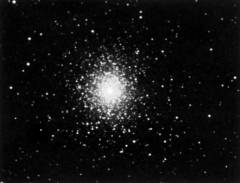
|
Messier object number 5 is quite bright and nice to look at, although fairly low in the sky from the my position in the UK, which makes it less spectacular than it would otherwise be if it were at the height of some of the other globulars such as M13 or M92. At this time of year the sky doesn't get fully dark, and globular clusters are the best deep sky objects to view since they are brighter than others. Even so, cloud has been a problem this month and I was only able to capture black and white images of this object on this occasion.
M5 is 24,500 light years away, and is notable for containing 105 known variable stars. I used my Vesta SC3 camera at prime focus of the Megrez 80 Super Apo telescope for this picture. I stacked 121 frames of 12 seconds each, in K3CCDTools, with dark and flat processing. Post processing was done in Iris, PixInsight LE, and The Gimp. | |||||
| to top | home | |||||
4 February 2007: M3 in Canes Venatici
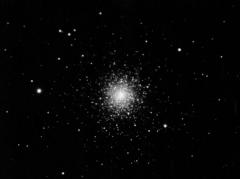
|
||||||
| to top | home | |||||
4 February 2007: M36 in Auriga
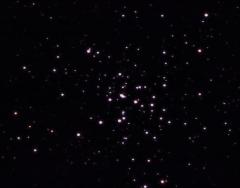
|
I was testing a newly-modified SC1.5 TouCam Pro, which will be used for guiding. I attached it to my Megrez 80 super apo and pointed at open cluster M36, one of the three messier open clusters in the constellation of Auriga.
I captured 93x9 seconds, unfiltered, at prime focus of the telescope. The frames were stacked in K3CCDTools and processed using PixInsight LE and The Gimp, following my usual routine. | |||||
| to top | home | |||||
13 January 2007: M45
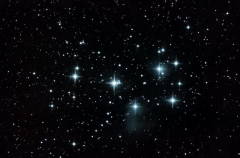
|
This is another picture of one of the most popular open clusters, M45 - the Pleiades or the Seven Sisters. In this image can be seen some of the blue glow of the reflection nebula, caused by light from the stars reflecting from a cloud of gas through which the cluster is passing.
This is a stack of 63 1-minute exposures captured using my Canon EOS300D camera set to 1600 ISO. The images were calibrated and stacked using dark, flat, and bias images in Deep Sky Stacker, then post-processed in PixInsight LE and The Gimp. | |||||
| to top | home | |||||
23 November 2006: M35 in Gemini and M37 in Auriga
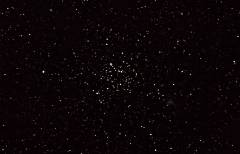
|
On 23 November I had decent polar alignment and 3-point alignment of the mount straight off. I took advantage of this by capturing some images of some open clusters.
For M35 I captured 9x30 seconds with the EOS300D at prime focus of my Megrez 80II SD, with a Baader contrast-booster filter. M35 is a big open cluster with a little faint one (NGC2158) close by, visible on the right of the main cluster in this image. The images were stacked in Deep Sky Stacker, and processed in PixInsight LE. Finally I used a new treatment designed to maintain star colours. This procedure in The Gimp was based on one pioneered by Noel Carboni's for Photoshop. | |||||
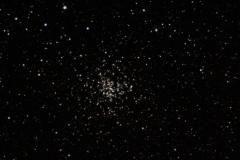
|
After M35 I captured 11x30 seconds on M37 in nearby Auriga. Like the previous image this was aligned and stacked in the highly-recommended software package Deep Sky Stacker, which can automatically convert DSLR "Raw" images and calibrate, align, and stack them to produce a composite image.
Following DSS I used PixInsight LE and The Gimp as usual to produce the final image shown here. |
|||||
| to top | home | |||||
10 September 2006: M92, Globular Cluster in Hercules
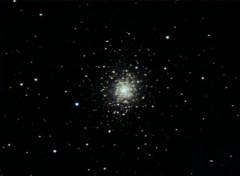
|
This globular cluster is smaller than its famous companion in the same constellation. But it's a nice target all the same. For this image I was practicing using the LRGB technique. The main problem with this issue was getting the colour balance right.
I captured 225x10 seconds for the luminance, and 90x10 seconds each for the Red, Green, and Blue channels using my cheap observing filters, as described on my filters page. The camera was my Vesta SC3 webcam on the Megrez 80IISD telescope. |
|||||
| to top | home | |||||
9 September 2006: M52 and NGC7789, Open Clusters in Cassiopeia
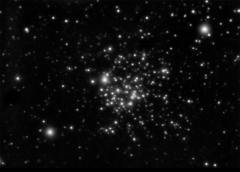
|
On 9 September I captured some frames of two open clusters in the constellation of Cassiopeia. I used my Vesta SC3 modified webcam attached to the Megrez 80 SD II refractor.
For M52 I stacked 107x15 seconds, and for NGC 7789 I stacked 52x12 seconds. Each stack was saved in FIT format and pre-processed using Carsten Arnholm's ImageTOOLSca software. | |||||
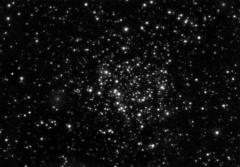
|
The calibrated frames were stacked in K3CCDTools, and post-processed in PixInsight LE, a program I am learning more of all the time. For these images I was experimenting with a masking technique whereby the large bright stars are used in negative form as a mask against themselves, to prevent overprocessing when applying curves and stretches to the rest of the image. NB. The blurred object to the left of NGC 7789 is a normal star. The halo is an artifact of this processing.
The final versions have been slightly upsampled from the original image. |
|||||
| to top | home | |||||
1 May 2006: M13, Globular Cluster in Hercules
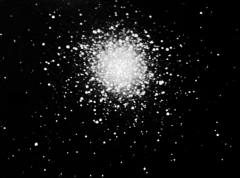
|
I was viewing this cluster with my newly-acquired Celestron C8 telescope, as a stopping-off point in my search for Comet 73P Schwassmann-Wachmann. I didn't find the comet, but I did capture some images of M13 with my Vesta SC3 camera in B∓W raw mode, with amp-off. I attached an Atik 0.5 focal reducer to the camera, giving an effective focal length of 500mm. It's the first time I've photographed this cluster using that camera, and I captured fainter stars than on any of the several previous occasions visiting this object.
I have found that capturing many relatively short exposures rather than fewer long exposures works better for this object, as it helps resolve the centre without overexposing it. I captured 25 frames of between 12 and 15 seconds each, of which 20 were good enough to stack. They were stacked using K3CCDTools and then post-processed using PixInsight LE and The Gimp. Next for this cluster is to capture some colour images. It would also be interesting to capture some longer exposures of the fainter outer regions, which could be merged with this one to form a composite. |
|||||
| to top | home | |||||
5 November 2005: M45, The Pleiades
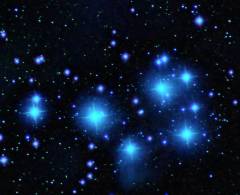
|
In contrast to my previous images of it, this picture of the Pleiades (M45) was taken using my EOS300D camera. It is formed of four images of five minutes each, captured at prime focus of my ST80 refractor. This length of exposure shows the reflection nebula around the bright stars, although more detail is possible with yet more exposures. | |||||
| to top | home | |||||
2 October 2005: M52 Open Cluster in Cassiopeia
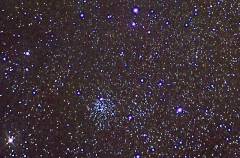
|
This is a good-sized open cluster in Cassiopeia. I captured it using my EOS300D digital SLR. I was hoping to pick up the Bubble Nebula too, which is located near the bright stars at the top centre of this picture, but more exposures are needed with the Canon camera, which is quite insensitive to the red colour of such nebulae.
This image is a stack of 19x30-second exposures. I stacked them using K3CCDTools and processed the image using PixInsight LE and The Gimp. |
|||||
| to top | home | |||||
6 September 2005: M56 Globular cluster with B&W SC3 camera
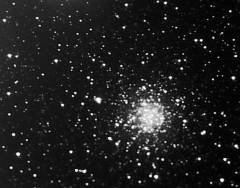
|
This image was one of the first pictures I captured using my newly-modified Vesta SC3 webcam. I used the camera without any filters so the picture is black and white.
Messier object 56 is a globular cluster in the constellation of Lyra, located between the famous double star in Cygnus, Albireo, and the most well-known of the planetary nebulae, the Ring nebula M57. M56 is a less bright globular than most of the well-known ones, and particularly doesn't have the very bright core that many others have. This latter characteristic makes it a little easier to resolve the stars at the centre. The camera was in B&W raw mode with Amp-Off, and I captured 100 15-second frames using K3CCDTools. I stacked 71 of them and processed the image in in PixInsight LE. Slight additional processing was applied in The Gimp. |
|||||
| to top | home | |||||
14 August 2005: Brocchi's Cluster - "The Coathanger"
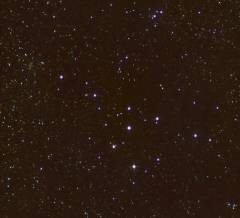
|
This is one of my favourite binocular objects, Collinder 399, or Brocchi's cluster in the constellation of Cygnus, the Swan - a cluster known informally as "The Coathanger" because of the shape formed by the 10 brighter stars in the centre of this picture (if you can't see the shape, look at it upside down).
I stacked a couple of exposures of the Coathanger (Collinder 399, or Brocchi's cluster). This image is composed of a two-minute and a 4-minute exposure, with the Canon EOS300D at ISO 800, at prime focus of the ST80 f/5 achromatic refractor. I post-processed in PixInsight LE, with further processing including blue halo removal and multiple luminance layering in The Gimp (Luminance was generated in The Gimp by decomposing to Y/Cb/Cr and using the Y layer). For more on this technique see Rob Gendler's website here. I was pleased to see in this photo, just to the top-left of the Coathanger asterism, a much smaller and fainter open cluster NGC6802. |
|||||
| to top | home | |||||
10 August 2005: A cluster of clusters - NGC 663 with 654 and 659
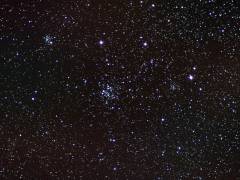
|
On the evening that I imaged these open clusters in the constellation of Cassiopeia I had intended to look for M103. However instead I came across NGC663. And when I looked at the image it had 654 and 653 in there too, and even IC 166 faintly in the lower left corner.
This is a stack of 8x2minute exposures, captured using the Canon EOS300D at ISO 800 through my ST80 f/5 refractor telescope. The images were stacked in K3CCDTools and post-processed in PixInsight LE and The Gimp. Finally, the spikes on the brighter stars are courtesy of two pieces of cotton taped across the telescope's aperture. |
|||||
| to top | home | |||||
2 August 2005: NGC 869 and NGC 884, the Double Cluster
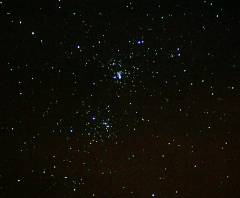
|
I captured a few images of this pair in the constellation of Perseus whilst focussing my telescope. Unfortunately clouds prevented any further images so I did my best with the two 5-second exposure I had. Fortunately it's a fairly bright subject, although I would have preferred a little more than 2x 5-seconds to work with!
These two frames were captured with the Canon EOS300D camera at prime focus of my ST80 f/5 refractor. The camera was set to ISO 1600. I combined the frames in K3CCDTools, then adjusted levels and curves and applied a little noise reduction in PixInsight LE. |
|||||
| to top | home | |||||
3 June 2005: M3, Globular Cluster in Canes Venatici
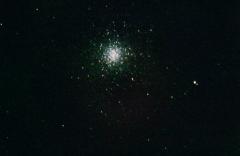
|
I decided to target this cluster with my Canon EOS 300D DSLR camera. M3 is one of the brighter globular clusters, although not as spectacular as M13 in Hercules. I found it easily in the binoculars, then the finderscope, and after some adjustment, got it focussed in the camera. The picture is a stack of 21x25-second images with the EOS 300D using a 2x barlow on my Europa 250. The camera was set to ISO 1600, and capture was in RAW mode. Images were converted from Canon Raw format to TIF using Canon's Image Viewer. It was aligned and stacked in K3CCDTools, then levels and curves adjustment, background extraction, noise reduction, and slight sharpening in PixInsight LE. Finally a little tweak in The Gimp. Unfortunately I forgot to take any dark frames so there are quite a few hot pixels in the image, although I have covered up the obvious trails using the Gimp's cut and paste facility. | |||||
| to top | home | |||||
13 February, 2005: M35 open cluster in Gemini with NGC2158
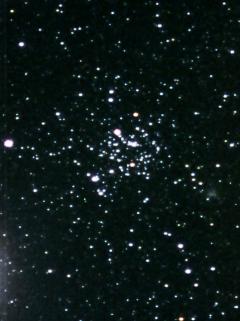
|
M35 is an open cluster in the constellation of Gemini. About two-thirds of the way down the right-hand side is a small fuzzy patch, that is another open cluster called NGC2158.
This was captured on a windy night, when the wind would have been too much for my telescope, so I used a 135mm SLR lens on the SC3000 SC1.5 modified webcam to image this object that just fits in the field of view given by that lens. This picture was made from a stack of 10x10 seconds and 10x20 seconds exposures processed using The Gimp. |
|||||
| to top | home | |||||
5 November 2004: M45, The Pleiades
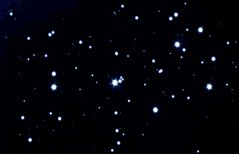
|
Another picture of the M45 open cluster, better known as The Pleiades or The Seven Sisters. I only captured 13 frames, of which 12 were usable: 10x45sec and 2x60sec in colour Raw mode. QC3000 SC1.5 with 135mm SLR lens stoped down one position to f/4.0. | |||||
| to top | home | |||||
11 October 2004: Messier 15 and Pease 1
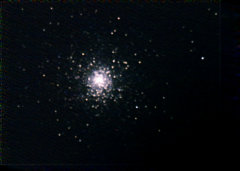
|
Messier 15 is another globular cluster, this time in the constellation of Pegasus. It is one of the most dense start clusters in the Milky Way and it seems to contain a collapsed core.
This image was was formed of 70x12 second frames chosen from 130 in colour raw mode, QC3000 SC1.5 prime focus of 216mm f/5 Newtonian. After debayering in AVIRaw I aligned and stacked in Registax, also applying wavelets slightly, then processed in Pleiades PixInsight LE followed by The Gimp. | |||||
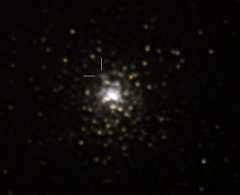
|
After processing the picture of M15 above, I realised that the cluster contains a planetary nebula called Pease 1 (or K648). My original processing lost that in the central glow, so I returned to the stacked image and tried an alternative process to bring out the nebula. It can just be seen as a blue blob in the picture, where I have marked it.
Like other planetary nebulae, Pease 1 is formed from the thrown-off shells of gas when a sun-like star uses up the main part of its nuclear fuel. More information on Pease 1 can be found at http://www.seds.org/messier/more/m015_pease1.html | |||||
| to top | ||||||
13 September 2004: M45, The Pleiades - "The Seven Sisters"
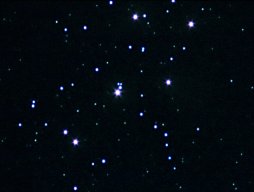
|
This picture of the famous open cluster in the constellation of Taurus was taken with a 135mm SLR lens on my QC3000 SC1.5, at f/4.0
Exposures were 3x40sec and 12x12sec in colour RAW mode, debayered in AVIRaw, dark-subtracted in iPrep, stacked in K3CCDTools, manipulated in the Gimp, and de-noised in NeatImage. |
|||||
| to top | home | |||||
6 September 2004: Messier 13
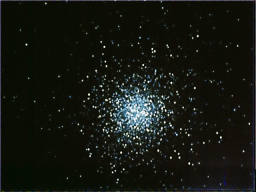
|
Another picture of M13, the great Hercules Cluster. It is one of the best examples of a Globular Cluster, many of which are scattered around the outskirts of our galaxy, each containing millions of stars. This picture was captured using the long-exposure capabilities of the modified QuickCam 3000. It also took advantage of RAW mode, which was then debayered (converted to normal colour) in AVIRaw. iPrep was used to remove hot pixels and the image was processed in the Gimp and NeatImage. In contrast to the previous picture of this cluster, 120 frames of 10 seconds each were stacked. The result is vastly improved over the earlier image. | |||||
| to top | home | |||||
3 September 2004: Messier 71 - Globular Cluster
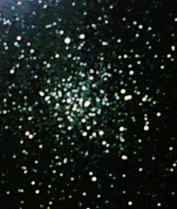
|
M71 is a globular cluster in the constellation of Sagitta, the Arrow. This cluster was previously thought to be a dense open cluster, but is now accepted to be a loose globular, 13000 light years away.
This image was 44x25sec using QC3000 SC1.5 in colour RAW mode. Process sequence: Aviraw, iPrep (for hotpixels), K3CCDTools, Gimp. |
|||||
| to top | home | |||||
1 September 2004: Messier 11 - The Wild Duck Cluster
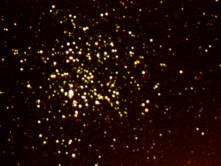
|
Messier 11 is an open cluster in the constellation of Scutum. Although it's an open cluster it is very rich and contains several thousand stars. This image is composed of 45 frames of 20 seconds each taken with my QC3000 SC1.5 in Raw colour mode. This is the first time I used Raw colour mode, which reprograms the webcam to gather images without all the built-in image processing - instead the image is converted on the PC. I used iPrep to remove dark pixels and then aligned and stacked in K3CCDTools 2. | |||||
| to top | home | |||||
10 August 2004: Messier 13
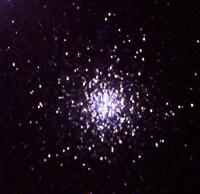
|
Messier object 13 is also known as the Great Cluster in Hercules. This picture was captured using the long-exposure capabilities of the modified QuickCam 3000. Unfortunately only 8 images were available to be stacked, each of 25 seconds. Compare with the image of M13 further down this page, taken with an unmodified camera. | |||||
| to top | home | |||||
16 June 2004: Messier 13
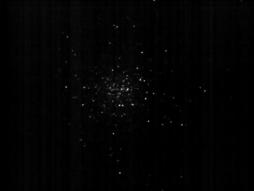
|
Messier object 13 is also known as the Great Cluster in Hercules. It is a globular cluster in our galaxy containing hundreds of thousands of stars, possibly a million (estimates vary). M13 is one of the brightest and best-known globular clusters and for this reason I was able to get a reasonable image, although many fainter stars are not visible without longer exposures. Also due to noise as a consequence of the high gain setting (click here to see an example), some faint stars were lost in image processing. This picture was created from the best 200 frames taken at 5fps. The shutter speed was set to 1/25s and gain about 80%. Gamma and saturation were set to maximum, although black and white mode was enabled on the camera. |
|||||
| to top | home | |||||
 |
||||||
| All text and images copyright and may not be used without permission |
||||||